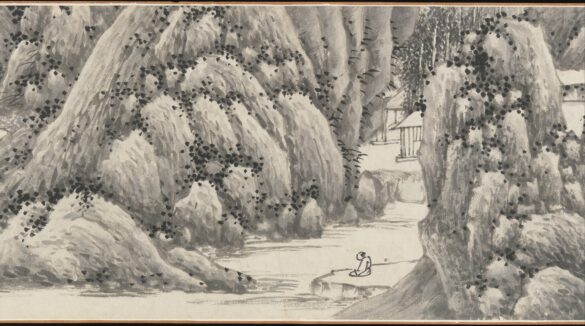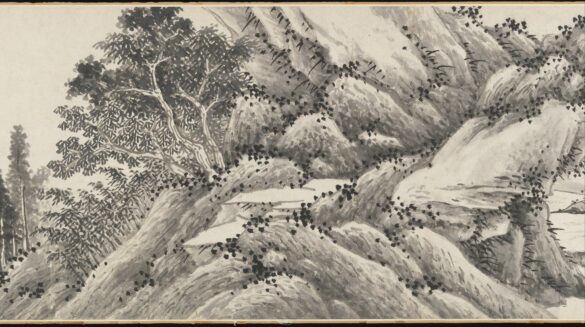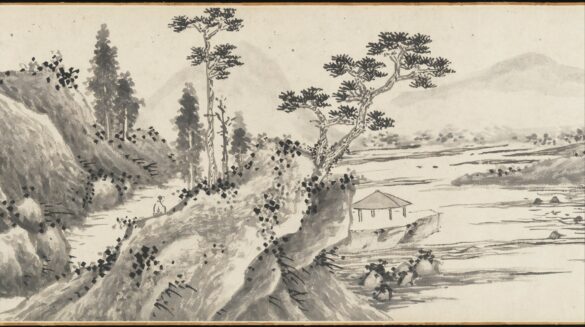
Joint Landscape (section 30), by Shen Jou, China, 1500s. Source: Metropolitan Museum of Art.
The tragedy of my parents’ otherwise excellent marriage was that my father had hawked librettos as a teenager so he could get standing room at the opera five nights a week, but my mother was tone-deaf; and my mother had been a passionate art history major, but my father was color-blind. The result of this aesthetic mismatch was that my father wanted company for performances and first took me to the Metropolitan Opera when I was six, while my mother wanted to give us the joy of visual art and started taking me to the Metropolitan Museum when I was still in a stroller. Her great passions were the Northern Renaissance, Impressionism, and Post-Impressionism; and her gentle, eager voice helped me imagine the rooms just out of view in a Pieter de Hooch painting or the luxuriance of Monet’s gardens.
My grandmother, also deeply fond of the Museum, was left to show me through Arms and Armor, Egypt, Greece, Rome, and all of Asia. I had a precocious penchant for the “exotic” — whether that meant, in my juvenile experience, dinner at Trader Vic’s or a peculiar appreciation for my great aunt’s pagoda-festooned china — and I engaged with the galleries of Chinese art most of all. I cannot pretend that I then had much insight into the fine points of Song dynasty brushwork, but I liked how different what was portrayed seemed from anything else I knew. I could readily imagine my way into Giverny, but to place myself in these landscapes required a spirit of adventure.

Joint Landscape (section 25), by Shen Jou, China, 1500s. Source: Metropolitan Museum of Art.
The two Mets seemed reassuringly permanent to me. I never countenanced the idea that they would both be shuttered (which they are as I am writing). I took children’s classes at the Museum and had my first job there — as the unicorn at the Medieval Festival at the Cloisters — when I was fifteen. In the summer of 1981, when I was a high school intern in the Met’s Editorial Department, I was asked to proofread the galleys for Wen Fong and Maxwell K. Hearn’s Silent Poetry: Chinese Paintings in the Douglas Dillon Galleries, an issue of the Bulletin. I was captured by the vivid prose and even more by the paintings themselves, to which I now turned my attention not because they were exotic but because they were exquisitely loaded with pertinent meaning. The following summer, I was fortunate enough to travel with my family to China. Although Western tourists were mostly sequestered from the local population at that time, Wen Fong had kindly placed a few calls from New York and arranged for us to break away from our tour group and visit Suzhou, then largely closed to foreign visitors. The following semester in college, I studied Chinese painting with Richard Barnhart. I later worked at, wrote about, and eventually became a trustee of the Museum, and in 2013 I joined the visiting committee of the Department of Asian Art.
In its monumentality, the Museum has always seemed both to contain and to transcend the works it houses. All my life, whenever I encountered an unforgiving world, there was The Met to revive me, comfort and safety to be found in its multifarious riches. When The Met’s great doors swung closed on March 12, we were all locked out of a place of escape and contemplation. But that place was hardly forgotten. Art was a comfort even when I couldn’t go and visit it. I could view representations of some paintings online and in my collection of catalogues; other works inhabited my inward eye, and I took comfort from it. As the reality of the quarantine slowly set in, I began to ponder what would reward months of solitary contemplation.

Joint Landscape (section 4), by Shen Jou, China, 1500s. Source: Metropolitan Museum of Art.
Isolation, so novel to most of us now, was a regular feature of life in dynastic China, where literati painters were often banished from court or chose to avoid its scandals and dangers. At a remove from the fray, they produced albums, hanging scrolls, and handscrolls, forms of art intended not for permanent display but rather for perusal at appointed leisure. From The Met’s spectacular collection I’d borrow Shen Zhou’s Joint Landscape, completed by his student Wen Zhengming, which is more than fifty-six feet long. Shen lived in the fifteenth century in Suzhou. Named by historians as one of the “Four Masters of the Ming,” he is noted for the distinctive mixture of restraint, mysticism, subtlety, and warmth that underlies his work. Shen chose to forego the life of a Ming official, living in retreat, as some of us find ourselves doing now. His scroll explores themes that preoccupied many Ming scholars: the private pleasures of secluded dwellings tucked into mountain valleys. It is dotted with tiny figures, pleasingly dwarfed by the magnificent topography that surrounds them. It is impossible to take in the totality of such a scroll in a single viewing.
Shen’s handscroll is intended to be savored over many days, like a leisurely sojourn in the mountains. Looking at it is like reading a long-form poem or a meditative work of fiction. Like a novel, it evinces s cogent monumentality yet is also sequential, meant to unfold slowly as life does. Such a handscroll would originally have been viewed one arm’s span at a time, an impossible practice in a museum display case; our compromise for viewing such work is antithetical to the intended intimacy and immediacy. Taking inspiration from his forebears, Shen deliberately harked back to Yuan and early Ming painters to create a body of work that is of its time but also transcends time. I like finding myself small in his world, reading each vital, calligraphic indication like a promise that splendor endures despite chaos and conflict. Shen expressed in an outer landscape much of what has unfolded in my inner landscape. Nature is vast, and we are no more than a few brushstrokes and a dot of ink. In professing Confucian inadequacies, Shen achieved a specific gorgeousness: humble, spectacular, at once simple (a gesture here, another there) and infinitely complex.

Joint Landscape (section 16), by Shen Jou, China, 1500s. Source: Metropolitan Museum of Art.
As the days of quarantine wore on, we found ourselves in a double trauma: of COVID-19 and an escalation in the long-simmering crisis of police brutality toward people of color. The cruel majesty with which nature seems to have chastened us suddenly coincided with the implacable smallness of humankind. If these twin crises seem novel, look to Shen Zhou to find evidence of how such truths have coexisted for civilization’s portion of eternity. It becomes clear that this is an evergreen juxtaposition: the scholar’s life of deliberate seclusion acknowledges an antithetical pettiness and barbarity that played out in the fifteenth century imperial court much as it does in the United States today. Racist acts here against people of Asian ancestry have escalated since the phrase “Chinese virus” began to proliferate under the instruction of our president. Unleashed into scapegoating, vicious elements in our society who might reasonably profane the appalling Chinese leadership have gone on the attack against innocent people, trying to place blame on them for what they never could or would have done. It is easy to see why one might flee to Jiangsu province and take up the brush.
COVID-19 in New York has necessitated a closing down of nonessential services, and cultural institutions sit high on the official list of nonessentials. Yet art offers a different redemption from that of medicine. The urgency of social-distancing regulations cannot be breached, but let us not suppose that museums are only pleasing distractions. Objects are repositories of insight; learning their truths is a medicine of its own. Dostoevsky said, “Beauty, though, will save the world.” If he was right, and on my better days I am sure he was, there is an armory’s worth of salvation locked up on Eighty-Second Street. Superb items such as this long handscroll speak to how others have understood, endured, and even subsumed privations and disruptions. They constitute a beacon of hope that we will not only survive our current punishments, but perhaps even be ennobled by them.

Joint Landscape (section 26), by Shen Jou, China, 1500s. Source: Metropolitan Museum of Art.
(To view and download digital reproductions of the entire handscroll,
please visit The Metropolitan Museum of Art website.)











